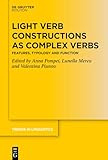Light Verb Constructions as Complex Verbs : Features, Typology and Function / ed. by Anna Pompei, Lunella Mereu, Valentina Piunno.
Material type: TextSeries: Trends in Linguistics. Studies and Monographs [TiLSM] ; 364Publisher: Berlin ; Boston : De Gruyter Mouton, [2023]Copyright date: ©2023Description: 1 online resource (VI, 372 p.)Content type:
TextSeries: Trends in Linguistics. Studies and Monographs [TiLSM] ; 364Publisher: Berlin ; Boston : De Gruyter Mouton, [2023]Copyright date: ©2023Description: 1 online resource (VI, 372 p.)Content type: - 9783110747850
- 9783110748116
- 9783110747997
- 415.6
- P281 .L55 2023
- online - DeGruyter
- Issued also in print.
| Item type | Current library | Call number | URL | Status | Notes | Barcode | |
|---|---|---|---|---|---|---|---|
 eBook
eBook
|
Biblioteca "Angelicum" Pont. Univ. S.Tommaso d'Aquino Nuvola online | online - DeGruyter (Browse shelf(Opens below)) | Online access | Not for loan (Accesso limitato) | Accesso per gli utenti autorizzati / Access for authorized users | (dgr)9783110747997 |
Frontmatter -- Contents -- Introduction -- Section 1: Argument structure sharing -- 1 Valency structure of complex predicates with Light Verbs -- 2 Unification and selection in Light Verb Constructions. A study of Norwegian -- Section 2: Event structure sharing -- 3 Persian Light Verbs as event determiners -- 4 Light Verb Constructions in Romance languages. An attempt to explain systematic irregularity -- 5 How light is ‘give’ as a Light Verb? A case study on the actionality of Latin Light Verb Constructions (with some references to Romance languages) -- 6 When lightness meets lexical aspect. A corpus-based account of English Light Verb Extensions -- Section 3: The verb fullness -- 7 Semantic Co-composition in Light Verb Constructions -- 8 On the unpredictability of Support Verbs. A distributional study of Spanish tomar -- 9 Making a move towards Ancient Greek Light Verb Constructions -- Section 4: The verb emptiness -- 10 Light Verbs and ‘light nouns’ in polysynthetic languages -- 11 A diachronic insight into the aspectual meaning in Light Verb Constructions. A case study in Mandarin Chinese -- 12 Light Verb Constructions in Latin. A study on (in) memoria and (in) animo habeo -- Index -- Index of languages
restricted access online access with authorization star
http://purl.org/coar/access_right/c_16ec
The notion of light verb constructions has been traditionally related to the ‘insignificance’ of the verb, which is described as a grammatical item only codifying TAM system and ϕ-features, whereas the whole predicative content is thought to be conveyed by the noun. This book deals with the light verb constructions as instances of complex verbs, intended as multi-predicational but monoclausal structures. This allows to deepen the actual verb lightness, the effective noun predicativity, as well as their effect on the cohesion of the construction. The papers in this volume reflect on the concrete contribution of noun and verb to the event and argument structure, and on the relevance of semantically different noun classes for the verb selection. From different theoretical approaches, data of a great variety of languages are investigated, such as Indo-European languages – both modern (Germanic, Slavic, Romance and Iranian languages) and ancient (Latin and Ancient Greek) – but also Mandarin Chinese, and different polysynthetic languages (e.g. Ket, Nivkh, Murrinh-Patha, Kiowa, Bininj Gun-wok, Ainu). The range of topics, languages and perspectives presented in this book make it of great interest to both theoretical and applied linguists.
Issued also in print.
Mode of access: Internet via World Wide Web.
In English.
Description based on online resource; title from PDF title page (publisher's Web site, viewed 25. Jun 2024)


